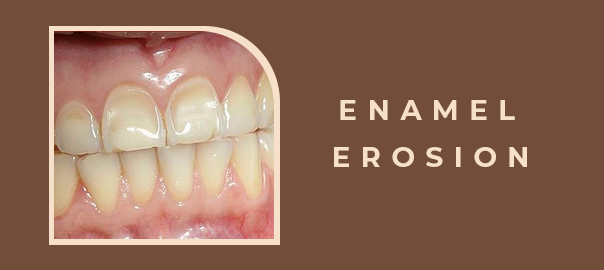
Enamel Erosion – Symptoms, Causes, Treatment
Your smile is often considered your best accessory, but what if the protective shield of your teeth, known as enamel, starts to wear away? Enamel erosion is a common dental concern that can lead to various oral health issues. In this blog, we will explore the symptoms, causes, and treatment options for enamel erosion to help you safeguard your precious smile.
Understanding Enamel Erosion
Enamel erosion occurs when the hard outer layer of your teeth, the enamel, begins to deteriorate. This can expose the underlying dentin, making your teeth more susceptible to sensitivity, discoloration, and decay. Recognizing the symptoms is crucial for early intervention and prevention of further damage.
Symptoms of Enamel Erosion
- 1. Tooth Sensitivity: Increased sensitivity to hot, cold, or sweet foods and beverages.
- 2. Discoloration: Teeth may appear yellowish as the enamel thins, revealing the dentin underneath.
- 3. Rounded Edges: Teeth may develop rounded or sandblasted edges.
- 4. Cracks and Chips: Weakened enamel is more prone to cracks and chips.
- 5. Dents on the Chewing Surfaces: Small dents, known as cupping, may appear on the biting surfaces of the teeth.
Causes of Enamel Erosion
- 1. Acidic Foods and Drinks: Regular consumption of acidic beverages like sodas, citrus fruits, and certain sports drinks.
- 2. Dry Mouth: Insufficient saliva fails to neutralize acids, contributing to enamel erosion.
- 3. Gastrointestinal Issues: Conditions such as acid reflux or GERD expose teeth to stomach acids.
- 4. Bruxism (Teeth Grinding): Excessive grinding can wear down enamel over time.
- 5. Improper Brushing: Aggressive brushing or using a hard-bristled toothbrush can damage enamel.
Treatment and Prevention
- 1. Desensitizing Toothpaste: Specialized toothpaste can help alleviate tooth sensitivity.
- 2. Fluoride Treatment: Professional fluoride applications can strengthen enamel.
- 3. Dental Bonding: In cases of minor enamel loss, dental bonding can restore tooth structure.
- 4. Dental Sealants: Applying sealants can protect vulnerable teeth from further erosion.
- 5. Lifestyle Changes: Limit acidic food and drink intake, stay hydrated, and maintain good oral hygiene practices.
- 6. Custom Mouthguards: For those with bruxism, wearing a custom mouthguard can prevent enamel wear during sleep.
Conclusion:
Enamel erosion may seem like a daunting concern, but with early detection and proactive steps, you can preserve your smile and overall oral health. Regular dental check-ups play a pivotal role in identifying enamel erosion and addressing it promptly. By understanding the symptoms, causes, and treatment options, you empower yourself to take charge of your dental well-being and keep your radiant smile intact for years to come. Remember, a healthy smile is a beautiful smile!
DISCLAIMER:Please note that the prices mentioned on this page: (a) present a range (depending upon the severity of the dental condition, the technology used in treatment, type of dental products used, etc.); (b) are true as on the date of this page and may change on a later date, in accordance with the standard company policy; (c) may be subject to standard aberrations or generalizations on account of the use of AI in general Google/internet search by you.Leave a Reply
Leave a Reply
Explore More Similar Posts
Explore More Blogs


Leave a Reply